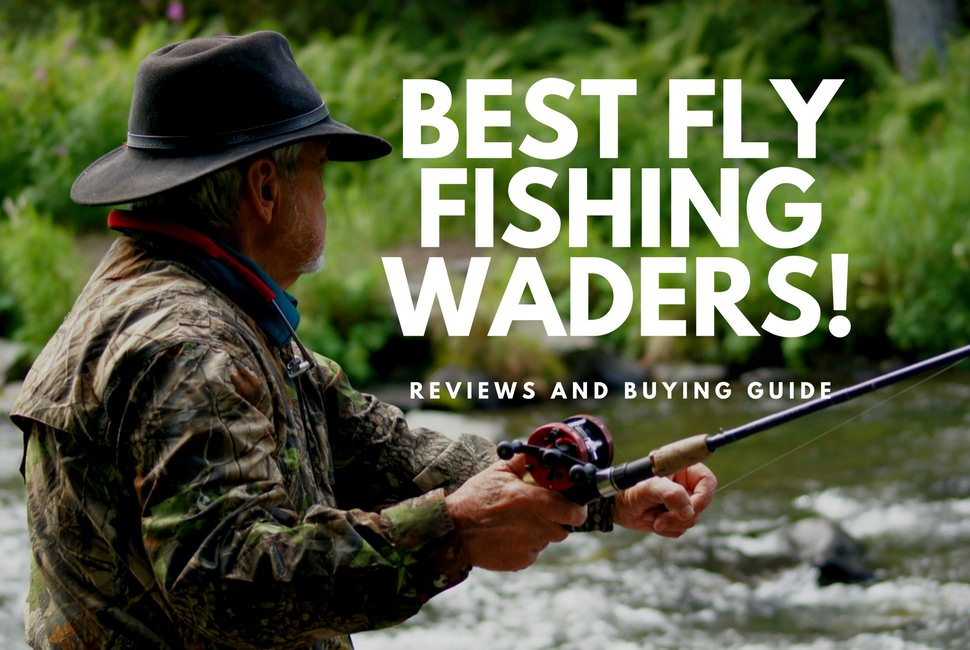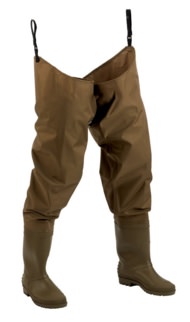Last Updated on February 17, 2022 by Afsar
Are you looking for the best Fly Fishing Waders? Fly fishing waders are one of the essential gear you need for fly fishing. There are several types of fly fishing waders available in the market in different price ranges. A casual fly fisherman might not need a wader, but a serious one would love to have one. Fly fishing waders will allow you to focus on the fishing process.
There was a time when wearing a fly fishing wader in summer was extremely tough. In those times, it was scorching hot inside those low-quality wading waders made of rubber and other low-quality materials. Nowadays, fly fishing waders are made in such a way that they offer breathability, comfort, and efficiency.
One common mistake done by the new anglers is that they think waders are a luxury; which is completely false. Fly fishing waders are there to help and focus on fishing solely. A new angler might choose a wrong fly fishing wader. This is why we have decided to put our hands on this issue and offer some of the best fly fishing waders to our users.
Table of Contents
Best Fly Fishing Waders 2022 – Waders Buying Guide
| Image | Model | Type | Material | Editor's Rating |
|---|---|---|---|---|
 | Toggs Amphib 3.5mm Neoprene Boot Foot Wader | Boot foot | Neoprene | 4.8 |
 | Caddis Men's Wader | Stocking Foot Wader | Neoprene | 4 |
 | Redington Crosswater Wader | Crosswater Wader | Polyester | 4.5 |
 | Redington Palix River Wading Pant | Wading Pant | Polyester & neoprene | 4.5 |
 | Caddis Men's Attractive Deluxe Wader | Stocking Foot Wader | Poyester | 4.8 |
 | Frogg Toggs Chest Wader | Chest Wader | Denier poly/rubber | 4.3 |
 | Caddis Women's Delux Wader | Stocking Foot Chest Wader | Poyester | 4.7 |
 | Waterfowl Wader | Stockingfoot | Neoprene | 4.2 |
 | Hodgman Hip Wader | Hip Wader | Nylon/PVC construction | 4 |
 | Oakiwear Childrens Neoprene Waders Camo 6/7 | Children Wader | Neoprene | 4.5 |
Toggs Amphib 3.5mm Neoprene Boot-Foot Wader
A lot of fly fishermen are depending on this amazingly built neoprene boot foot waders. The thickness level of neoprene is 3.5-mm. There are several sizes of this wader to fit differently sized fly fisherman. The hi-back upper design looks stylish and efficient.
If you check the image, you will see that the knee is reinforced with neoprene knee pads for more safety. What’s more, there is a fleece-lined hand warmer chest pocket for you to use in a cold environment. This wader comes’s at a very reasonable price and offers excellent durability and efficiency.
Notable Features:
- 3.5-mm neoprene
- sturdy, stylish and effective design
- reinforced with neoprene knee pads
- Fleece-lined hand warmer chest pocket
- Available in different size
How to Choose the Best Fishing Wader?
We are focusing on some of the most crucial features of how to choose the best fishing wader. These factors and points will provide you the important and necessary steps to choosing the best wader for you.
Breathability
A fly fishing wader needs to be breathable. This is one of the most important issues which need to be checked first. Usually, breathable waders are made of Gore-tex, dri-plus or other synthetic material. However, if you are into a cold area, then you may need a fly fishing wader which can prevent the cold from attacking you. In that case, neoprene fly fishing wader might be a right choice. Neoprene fly fishing wader offers great insulation against the cold.
Boot-foot Waders vs Stockingfoot waders
Boot-foot Waders
Boot-foot waders have a boot welded to the bottom of the wader. If you want to get quickly off and on the wader quickly, then this is a fantastic option. These are suitable for an easy to access and walk fishing location.
Stockingfoot Wader
In this type of wader, there are neoprene socks welded to take your foots. However, you will need to have wading boots to use this wader. The neoprene socks will keep your feet waterproof, and the wading boot will protect your feet from other damages you may get in the rocky area. My vote will go for stocking foot wader.
Weight
It is highly recommended to use lightweight waders. Otherwise, you may find moving dissatisfying and painful. Usually, rubber waders are cumbersome and dissatisfying regarding moving.
Material
Material plays a significant role while choosing a wader for fly fishing. Previously waders made of rubber were very popular. One of the main reasons for choosing rubber wader was their price. People still do use rubber wader for their low price. However, I discourage the usage or rubber and nylon waders as they are not breathable. As we have talked earlier in this post that a breathable material is best for a wader, as they are lightweight and water proof. A breathable wader will keep the moisture to fade away and keep you fresh while fishing. If you are fly fishing in a cold area, then you can choose neoprene as they are light and provides excellent insulation to the users.
Weather factor
If the weather is cold, then it is better to use a neoprene wader. As they are lightweight and offers great insulation, they are my first choice for the winter season. However, in hot areas, it is better to choose a breathable wader as they keep you fresh.
Do I really need A wader?
Some fly fisherman argues that having a good wading boot is enough in some situations. There are several reasons why you may need or not a fly fishing wader. By getting the best fly fishing waders, you can fight with the wilderness and make best out of your fishing time.
- Weather: Assume that you are fly fishing in a warm weather and the nature of the area is under control. In that case, you may not need to use wader. However, it varies from people to people. As using a wader allows you to move without any hesitation, you may feel it difficult when you don’t have any wader. On the other hand, in a cold area, it is highly suggested to use a wader to keep you warm and insulated.
- Fly fishing from kayak: If you are fly fishing from a kayak or boat, you can ditch the wader. However, if you need to get down from the kayak then you better use a wading boot. We have an article on the best wading boots. Fly fishing from boats, kayaks, and canoes are getting familiar. If you have any of the boats, you can try it by yourself.
- Flexibility: If an angler wants to ditch the wader for a while, s/he may need to limit their flexibility which they could have achieved with the wader. In my opinion, it is better to have a wader, or rent one from the local store/shop.
Different types of Waders
We have already talked about the various types of waders at the beginning of this article. We are going to share more details on the types of wader.
Boot-foot Waders
Boot-foot Waders will cover the angler’s foot to the chest. The foot is attached/welded to the upper portion and offers less flexibility. Even though many anglers still use them, but a professional angler wouldn’t use these waders for their lack of flexibility. It is quite tough to move with these waders for a long time.

Another significant drawback of the Bootfoot Wader is their weight. Since the boot is welded, the weight increases, and it makes the angler uncomfortable. A good thing about the bootfoot wader is that you don’t have to buy them separately. The irony is that; you can’t use them separately if you want.
Stockingfoot Wader
Most of the fly fisherman are using stocking foot wader for better flexibility. These are the standard wader except the attached boot. They come with neoprene sock which will go behind the wading boots. You need to purchase wading boots separately for this type of wader.
Stockingfoot waders are usually easy to manage and easy to store. These waders may be expanded to the chest or may be in the waist. If it is extended from the leg to waist, then it will have a very low weight comparatively other waders. These types of waders can be managed very easily.
Stockingfoot wader allows you to fish without using the boot if wanted. Though there are little chances that you may want to use the wader only. However, if the condition is right for you, then you may use the wader only. Note that; wading boot offers excellent traction on the water which you may not want to miss.
Chest Wader
These are just another types of popular wader used by the serious angler or in the rough environment. These can be found in stocking foot and boot foot version also. Both men and female usually wear These fishing waders. Sometimes these waders offer better-customized pockets for storing important stuff.
Hip Wader and pant
I am pretty sure that you have already heard of the hip waders and wading pants. Hip waders are used in the shallow or slow moving water. Just like the boot and without boot waders, these waders also have the option to choose or omit boots.
Hip waders are excellent for usage in the summer days. You will be amazed to know that hip waders can be used in cold weather also. Note that extreme cold weather may require you more safety. It is highly recommended to use the wading boot to protect your leg while hiking or fly fishing in rocky places.
Hip waders are very easy to manage and store. They take very less space than the usual waders and can be kept in the backpack easily and quickly. You can tie the wading boot in the backpack and start your journey. Another good reason to purchase a hip wader is their low cost.
Almost same thing goes with the wading pant. They are intended to be used in the shallow and slow-moving water. They are just like regular pants and fits comfortably. Note that these wader pants can’t be used in water level above the waistline. So if you are thinking about getting into deep water, then you better choose other waders.
Where to buy the best fly fishing waders?
Good Read:

Afsar is an avid kayak blogger born near the coast. He has a passion for kayaking and started as a child. He has paddled in various conditions and locations and promotes responsible kayaking. Afsar’s blog is widely read, and they are a respected voice in the kayaking community, offering valuable content on kayaking trips, gear, tips, and tricks. Afsar collaborates with other bloggers and brands and continues to inspire others through their writing and social media.





